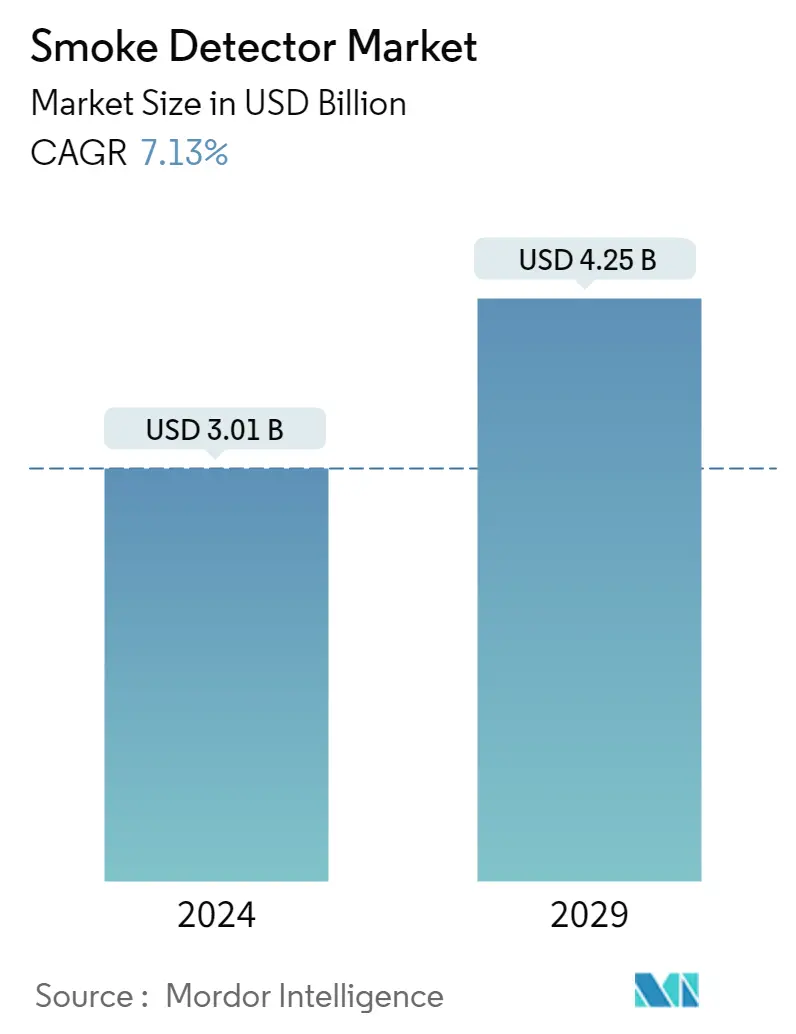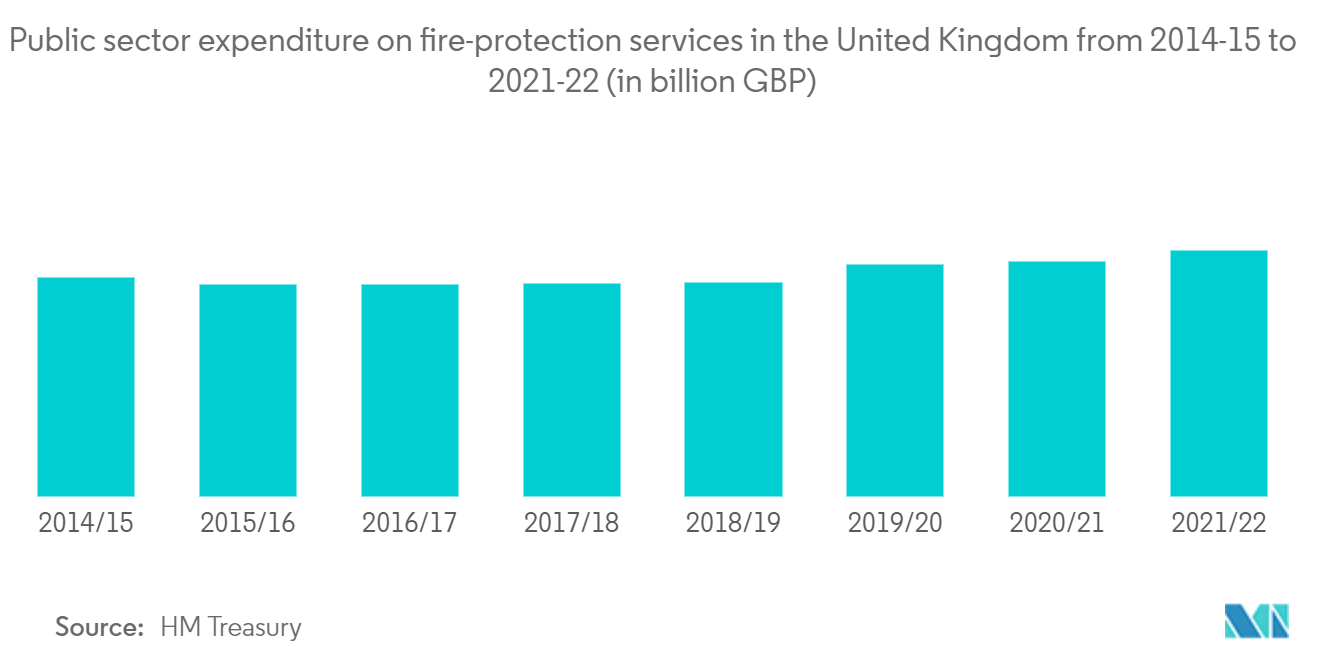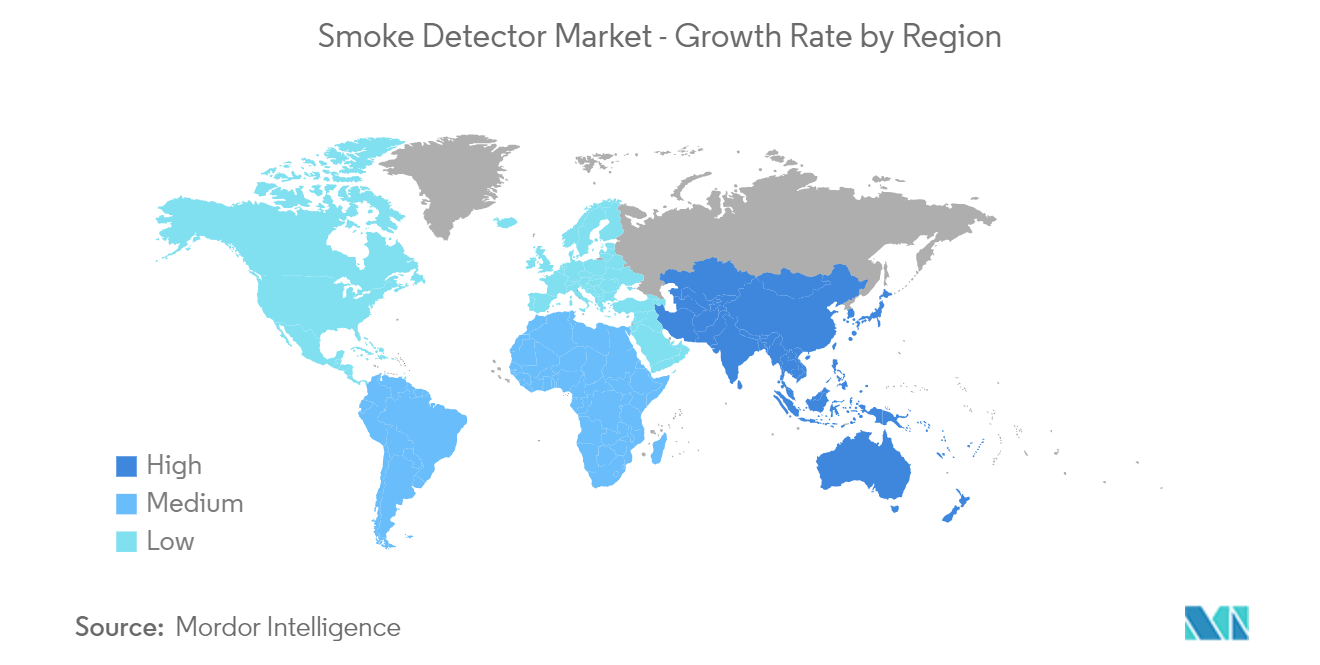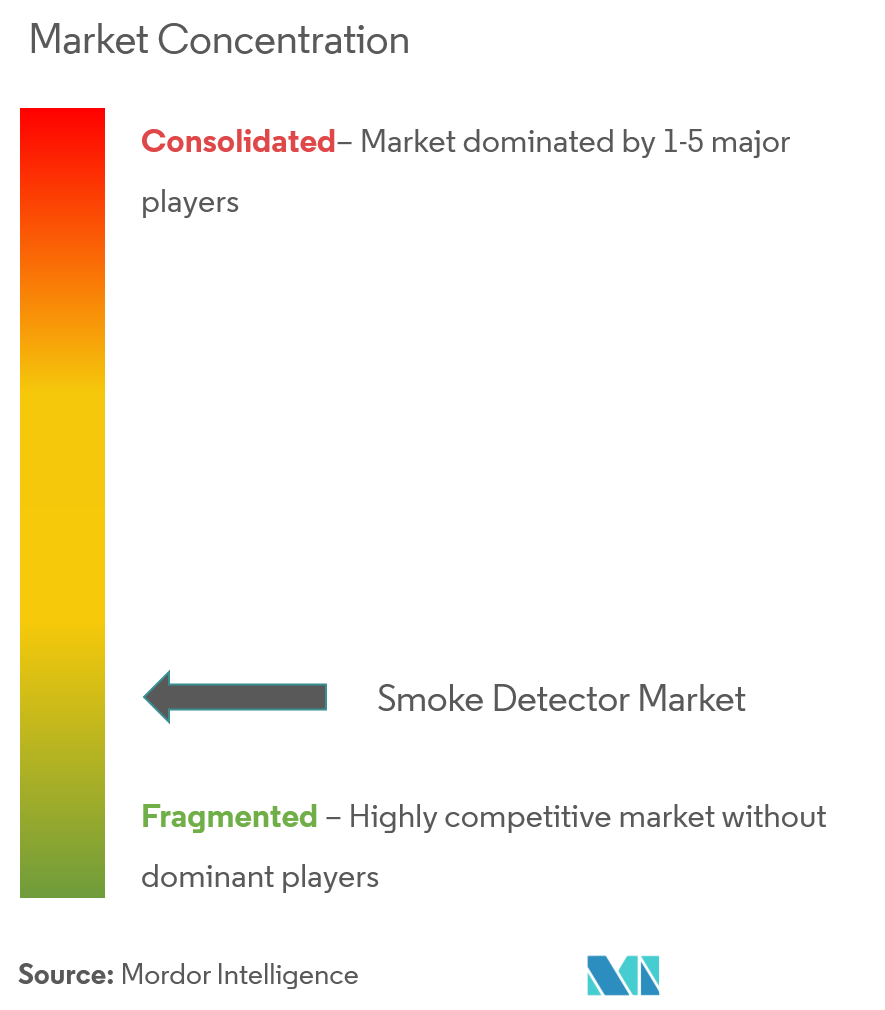Smoke Detector Market Size

| Study Period | 2019 - 2029 |
| Market Size (2024) | USD 3.01 Billion |
| Market Size (2029) | USD 4.25 Billion |
| CAGR (2024 - 2029) | 7.13 % |
| Fastest Growing Market | Asia-Pacific |
| Largest Market | North America |
Major Players
*Disclaimer: Major Players sorted in no particular order |
Smoke Detector Market Analysis
The Smoke Detector Market size is estimated at USD 3.01 billion in 2024, and is expected to reach USD 4.25 billion by 2029, growing at a CAGR of 7.13% during the forecast period (2024-2029).
The latest trend of IoT-enabled smart smoke-detecting service helps customers to prevent false alarms and offers enhanced security with advanced risk monitoring and instant action in any adversity. Customers can turn off the alarm via their IoT-enabled devices in case of false alarms, and the IoT-enabled system notifies the user about the need to change or replace batteries and other wearables. Also, the amalgamation of smartphones will drive the smoke detector market in the forecast period.
- A smoke detector is critical for the early detection of a fire in the residential, commercial, as well as industrial segments throughout the world. In a fire, smoke and deadly gases tend to spread farther and faster than heat, leading to death from inhalation of smoke and toxic gases. The growth of the commercial realty sector and IT industry to safeguard high-value assets such as data centers, manufacturing plants, powerhouses, buildings, and IT infrastructure is attracting the demand for fire safety equipment.
- Implementation of residential safety standards is driving the market. The increase in concern about fire safety has prompted the guidelines to be set by the US Fire Administration (USFA). Smoke detectors must now be installed inside every bedroom, outside each sleeping area, and on each level of the home, including the basement, and one carbon monoxide detector on each level and in each sleeping area. Photoelectric detectors tend to be more commonly used in homes, as they are quick to detect smoke coming from burning fabrics and furnishings.
- However, there are certain complications in installing smoke detectors. For instance, installing smoke detectors on a mounting surface that could be considerably cooler or warmer than the room, such as on an exterior wall or ceiling with poor insulation, is a key challenge for the market.
- One of the most emerging trends in the smoke detector market is the amalgamation of smartphones. Smartphone-connected smoke detectors are convenient since they can be easily disabled and work well at any place in the home that is prone to steam or cooking smoke, such as the kitchen or near bathrooms.
- Furthermore, the Internet of things (IoT) is being implemented in all electronic devices and instruments, from light bulbs and refrigerators to doorbells and garage doors. With almost anything now being controlled at the touch of a smartphone, it is not surprising that security integrators are incorporating the technology in smoke detectors. The growth of the commercial realty sector and IT industry to safeguard high-value assets such as data centers, manufacturing plants, powerhouses, buildings, and IT infrastructure is attracting the demand for fire safety equipment.
- The COVID-19 outbreak had an impact on the smoke detector industry. Owing to the quick spread of the virus, many organizations worldwide have been compelled to shut down, causing a demand-supply gap, a lack of workers, a delay in manufacture, and a postponement in the shipment of supplies and other parts of smoke detectors. On the other hand, the restoration of production activity has culminated in a large increase in the implementation of smoke detectors in the residential, healthcare, and production end-use industries, which is expected to contribute to market expansion.
Smoke Detector Market Trends
This section covers the major market trends shaping the Smoke Detector Market according to our research experts:
Residential Applications to Drive the Demand for Smoke Detectors
- The residential end-use segment is expected to witness significant growth throughout the study period. With increasing focus on safety across homes, smoke and fire detectors are increasingly being used. Government officials in developed nations such as the United States, Canada, and Japan have altered their standardized building standards and regulations to allow the installation of home smoke-detecting systems, therefore contributing to market development.
- Photoelectric and ionization smoke detectors are widely used in residential properties. In a residential setting, photoelectric alarms are more responsive to smoldering fires, whereas ionization detectors are better for flaming fires.
- Smoke detectors in residential applications should understand the most recent NFPA 72 and National Fire Alarm and Signaling Code requirements. When a very large residence contains floor areas greater than 1,000 square feet (excluding garage areas), the code requires smoke alarms to be installed on the ceiling, where photoelectric smoke detectors are permitted, which increases the market growth.
- Moreover, the United Kingdom has witnessed an increase in fire services over the past few years. Further, with the expansion of smart homes trend across the world, the demand for smoke and fire detectors has increased. Thus, the installation of smoke detectors in the residential segment is expected to grow further.
- All residential units and commercial buildings in Canada must meet the standards of several national regulatory codes, including the National Fire Code (NFC), the National Building Code (NBC), and the Provincial Code. According to NBC, smoke detectors must be installed in all new dwelling units, sleeping rooms, and on every floor of these units throughout the country. Strict fire safety regulations are thus promoting the growth of the smoke detector market in the coming years.

North America Accounts for a Significant Market Share
- According to the guidelines set by the US Fire Administration (USFA), smoke detectors must be installed inside every bedroom, outside each sleeping area, and on each level of the home, including the basement, and one carbon monoxide detector on each level and in each sleeping area.
- Also, government regulations have mandated the use of these devices in potentially hazardous environments, increasing the demand for smoke detectors in the country. According to a study by the Centers for Disease Control and Prevention, in January 2022, every year, at least 430 people die in the United States from accidental Carbon Monoxide poisoning. Approximately 50,000 people in the country visit the emergency department each year due to accidental carbon monoxide poisoning.
- As a result, the adoption of smoke detectors has seen an incremental demand. These devices help prevent these toxic and dangerous gases from building up in homes during a fire incident.
- According to the National Fire Protection Association (NFPA), the death rate per 1,000 reported home fires was significantly more in homes that did not have working smoke alarms (12.3 deaths per 1,000 fires), primarily because the smoke alarm was not present or the alarm was present but did not operate properly, than in the homes that had working smoke alarms installed (5.7 deaths per 1,000 fires). In the fire incidents where the smoke alarms were present but did not operate properly, more than two of every five (43%) smoke alarms had missing or disconnected batteries.
- The growing awareness about the hazardous effects of the release of carbon monoxide (CO) from the US Consumer Product Safety Commission and the National Fire Protection Association (NFPA) is further boosting the growth of the market in the country.

Smoke Detector Industry Overview
The market for smoke detectors is fragmented because of the high level of competition between the players. The vast majority of the players functioning in the global market are taking steps to raise their market footprint by concentrating on product diversification and development. Key players are Honeywell International Inc., ABB Group, and Siemens AG.
- August 2022 - Honeywell introduced Fire-Lite, a suite of fire protection systems for small to medium-sized buildings in Australia. The easily installed solution provides cost-effective, advanced fire detection and protection in recent and existing buildings to help keep people and property safe.
Smoke Detector Market Leaders
-
Honeywell International Inc.
-
ABB Group
-
Siemens AG
-
Hochiki Corporation
-
Johnson Controls International PLC
*Disclaimer: Major Players sorted in no particular order

Smoke Detector Market News
- January 2022 - Kidde launched its Smoke + Carbon Monoxide Alarm, which has various smart features, and Wi-Fi connectivity and could be managed via a new mobile app. The company's new smoke alarm would be one of the first smart systems which could be used for transforming existing Kidde hardwired interconnected alarms into smart ones with a full and easily integrated solution that offers whole-home protection.
- April 2021 - Siemens AG's Smart Infrastructure business boosted its portfolio for the small to medium-sized property sector with the release of Cerberus FIT, a new edition of the fire prevention system.
Smoke Detector Market Report - Table of Contents
1. INTRODUCTION
- 1.1 Study Assumptions and Market Definitions
- 1.2 Scope of the Study
2. RESEARCH METHODOLOGY
3. EXECUTIVE SUMMARY
4. MARKET DYNAMICS
- 4.1 Market Overview
-
4.2 Market Drivers
- 4.2.1 Increasing Concerns for Fire Safety
- 4.2.2 Implementation of Residential Safety Standards
- 4.2.3 Innovation in Sensor Technology
-
4.3 Market Restraints
- 4.3.1 Complications Regarding Installation of Smoke Detectors
- 4.3.2 Higher Costs of Replacements of Traditional Smoke Detectors with Smart Smoke Detectors
- 4.4 Industry Value Chain Analysis
-
4.5 Industry Attractiveness - Porter's Five Forces Analysis
- 4.5.1 Threat of New Entrants
- 4.5.2 Bargaining Power of Buyers
- 4.5.3 Bargaining Power of Suppliers
- 4.5.4 Threat of Substitute Products
- 4.5.5 Intensity of Competitive Rivalry
5. MARKET SEGMENTATION
-
5.1 By Technology Type
- 5.1.1 Ionization Smoke Detection Device
- 5.1.2 Photoelectric Smoke Detection Device
- 5.1.3 Beam Smoke Detection Device
-
5.2 By End-user Industry
- 5.2.1 Commercial
- 5.2.2 Residential
- 5.2.3 Transportation & Logistics
- 5.2.4 Oil & Gas
- 5.2.5 Other End-user Industries
-
5.3 Geography
- 5.3.1 North America
- 5.3.1.1 United States
- 5.3.1.2 Canada
- 5.3.2 Europe
- 5.3.2.1 Germany
- 5.3.2.2 France
- 5.3.2.3 United Kingdom
- 5.3.2.4 Rest of Europe
- 5.3.3 Asia-Pacific
- 5.3.3.1 China
- 5.3.3.2 Japan
- 5.3.3.3 South Korea
- 5.3.3.4 Rest of Asia-Pacific
- 5.3.4 Rest of the World
- 5.3.4.1 Latin America
- 5.3.4.2 Middle East & Africa
6. COMPETITIVE LANDSCAPE
-
6.1 Company Profiles
- 6.1.1 Honeywell International
- 6.1.2 ABB Group
- 6.1.3 Siemens AG
- 6.1.4 Hochiki Corporation
- 6.1.5 Johnson Controls International PLC
- 6.1.6 Robert Bosch GmbH
- 6.1.7 Mircom Group
- 6.1.8 Kidde Fire Safety (United Technologies Corporation)
- 6.1.9 TycoFIS (Tyco International Ltd)
- 6.1.10 Nittan Co., Ltd.
- 6.1.11 Nest Labs (Google LLC)
- *List Not Exhaustive
7. INVESTMENT ANALYSIS
8. MARKET OPPORTUNITIES AND FUTURE TRENDS
** Subject To AvailablitySmoke Detector Industry Segmentation
Smoke detectors are employed to detect smoke in the surrounding environment. In case of a fire emergency, the system can trigger alarms and activate safety systems. The systems come in different types depending on the use and environment used, where both photoelectric and ionization detectors are effective smoke sensors. These systems are really important and are being employed in many commercial and residential areas.
The smoke detector market is segmented by technology type (ionization smoke detection device, photoelectric smoke detection device, beam smoke detection device), end-user industry (commercial, residential, transportation & logistics, oil & gas), and geography.
| By Technology Type | Ionization Smoke Detection Device | |
| Photoelectric Smoke Detection Device | ||
| Beam Smoke Detection Device | ||
| By End-user Industry | Commercial | |
| Residential | ||
| Transportation & Logistics | ||
| Oil & Gas | ||
| Other End-user Industries | ||
| Geography | North America | United States |
| Canada | ||
| Geography | Europe | Germany |
| France | ||
| United Kingdom | ||
| Rest of Europe | ||
| Geography | Asia-Pacific | China |
| Japan | ||
| South Korea | ||
| Rest of Asia-Pacific | ||
| Geography | Rest of the World | Latin America |
| Middle East & Africa |
Smoke Detector Market Research FAQs
How big is the Smoke Detector Market?
The Smoke Detector Market size is expected to reach USD 3.01 billion in 2024 and grow at a CAGR of 7.13% to reach USD 4.25 billion by 2029.
What is the current Smoke Detector Market size?
In 2024, the Smoke Detector Market size is expected to reach USD 3.01 billion.
Who are the key players in Smoke Detector Market?
Honeywell International Inc., ABB Group, Siemens AG, Hochiki Corporation and Johnson Controls International PLC are the major companies operating in the Smoke Detector Market.
Which is the fastest growing region in Smoke Detector Market?
Asia-Pacific is estimated to grow at the highest CAGR over the forecast period (2024-2029).
Which region has the biggest share in Smoke Detector Market?
In 2024, the North America accounts for the largest market share in Smoke Detector Market.
What years does this Smoke Detector Market cover, and what was the market size in 2023?
In 2023, the Smoke Detector Market size was estimated at USD 2.81 billion. The report covers the Smoke Detector Market historical market size for years: 2019, 2020, 2021, 2022 and 2023. The report also forecasts the Smoke Detector Market size for years: 2024, 2025, 2026, 2027, 2028 and 2029.
Smoke Detector Industry Report
Statistics for the 2024 Smoke Detector market share, size and revenue growth rate, created by Mordor Intelligence™ Industry Reports. Smoke Detector analysis includes a market forecast outlook to 2029 and historical overview. Get a sample of this industry analysis as a free report PDF download.



